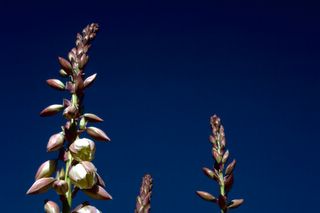Yucca is perennial was Legislated the New Mexico State flower in 1927. It's sharp leaves may reach a length of up to two feet. The flowers grows in bunches of ten or more on a long spike two to three feet long. They are greenish-white as we see in this photo and each bud may be up to 2 1/2 inches long. At maturity, these are home to the plants long black seeds.
The yucca's short blooming season runs from June to July. Domestic live stock eat the flowers and seedpods. Native Americans found many uses for the yucca. Roots for the production of soap and hair tonic, the flowers as well as seed pods are eatable, the sharp leaf tips amd fibers were used as needles and thread.
Yucca is a member of the agave family (Agavaceae) which includes about 600 species. Members of this family are used to produce fiber and alcoholic drinks (tequila, pulque, and mescal). The genus Yucca contains about 40 species, including the Joshua tree of the Mohave desert. Yucca is a Haitian name, glauca means "blue-green". Y. glauca was first described by English botanist-naturalist Thomas Nuttall in 1813.
Photo frrom the U.S. Fish and Wildlife Service's online digital media library. Presently, the library system contains the National Image Library--the Service's collection of public domain still photos.
 | (Yucca glauca) AKA "soapweed", "beargrass", and "Spanish bayonet" grows in a wide range from Canada to the Mexican border and may be found at elevations of more than 8,000 ft. |
Text references Native Wildflowers of the North Dakota Grasslands by Harold A. Kantrud State Trees and State Flowers by USDA
Leave a comment, make a request, Let this small sampling be a guide to better quality, more plentiful, public domain, royalty free, copyright free, high resolution, images, stock photos, jpeg, jpg, free for commercial use, clip art, clipart, clip-art.













No comments:
Post a Comment